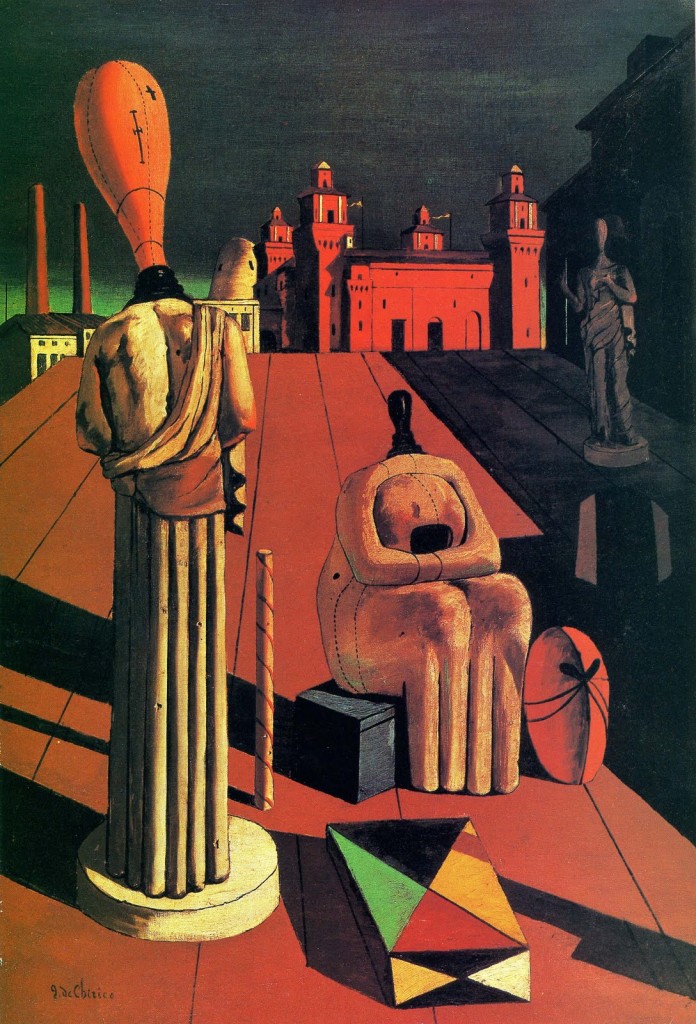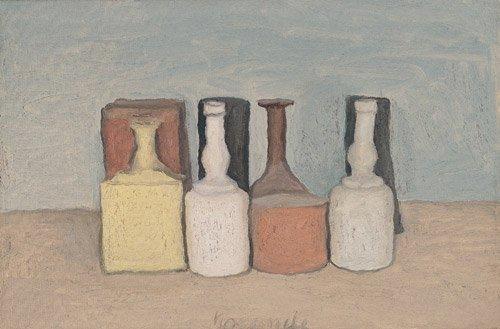The subject of metaphysics has been discussed recently so I thought it an opportune time to write a little about the painter de Chirico, he was born in Greece, his father was an Italian engineer. While in Greece he studied art at the Polytechnic Institute in Athens, he was to move quite often, between 1906 and 1909 he studied at the Academy of Fine Arts in Munich, de Chirico was interested not only in painting but also in architecture, music and philosophy, especially the work of Nietzsche who had interpreted and published work on Greek tragedy, de Chirico wished his work to connect with Nietzschean motifs, themes and his actual life, he believed that his paintings ‘could embody a philosophical message, a collusion and collision between Modernism and Post Modernism,’ he wrote pamphlets on the subject. Nietzsche had written about Greek myths, for example he discussed the relationship between the brothers Apollo and Dionysis, sons of the god Zeus, they had different characteristics but Nietzsche found no conflict existing in their personalities, he saw a fusion of these characteristics, unlike later philosophers who claimed that there was a dichotomy, de Chirico agreed with Nietzsche. Apollo the sun god, was characterised as being the dreamer, reason was attributed to him together with logical thinking and creativity, Dionysis on the other hand was the god of wine, chaotic, prone to ecstacy and intoxication.
In 1909 the family moved to Ferrara in Italy, de Chirico was twenty one, between 1911 and 1915 he stayed in Paris where he met many artists, he had rejected Romanticism and Impressionism, he preferred to express the enigmatic side of ancient myth, Picasso was also interested in classical Greek myths as had many Renaissance artists. De Chirico was called up to do national service during WW1 but was not fit for service, so worked in a hospital in Ferrara where he met the artist Carlo Carra, together they formed the Metaphysical Art movement,- Pittura Metafisica – the bulk of the work in this genre was produced between 1911 and 1920. It has been said that de Chirico reached a watershed in the way that the arts of the early 20thc. was evolving, he constantly invented and portrayed the body in new ways in relation to space.
The work of Freud was influential, we have thinkers today who study how the mind functions, but Freud was a father figure, his work on interpreting dreams interested many painters including the Surrealists, de Chirico soon distanced himself from the Surrealists, they liked to paint memories of their dreams where reality and dream worlds mingle, also they were made aware of the irrational impulses which influence behaviour as referred to by Freud.
De Chirico was impressed by the grandeur of Italian piazzas particularly those in Turin, he painted architectural scenes which cast long shadows, giving the paintings an eerie atmosphere which are rather threatening at times, he was obsessed with the presentation of enigma- ‘poetic revelations, the eternal meanings of things as he saw it or the enigma of things and bodies.’ His landscapes and dark toned skies created a sense of the mysterious – De Chirico’s use of titles such as The Enigma of the Oracle and the Enigma of an Autumn Afternoon helped to further the mysterious character of the work. There seems to be no rational explanation for the strange juxtaposition of his images, we have to trust that these were his dreams and his interpretation of them, perhaps they emerged from somewhere deep in his conscious or unconscious mind, it would be interesting to hear your views?
I have chosen his painting entitled The Disquieting Muses, painted around 1917, he was imagining the enigmatic side of ancient mythic creatures, in the background we see, set among industrial buildings, the Castle of Estense, in the front are two muses, Melomenes and Thalia, the muses of Tragedy and Comedy, one is standing, the other is sitting on a blue/green coloured box, de Chirico liked to use geometric shapes such as the box. The sky is a dark green with light on the horizon, is it dawn or dusk? The main source of light comes from the direction of the lower right side of the painting, creating long shadows, a contrast between light and dark, the muses are dressed in classical Greek clothes they are like faceless mannequins, it was thought that to give them features would have lessened their impact as portraying the human spirit, they would become too ordinary. He uses ochres and browns, the muses are a yellow/cream colour, we also see a mask and a staff and the god Apollo stands on a plinth, he is the leader of the muses. De Chirico was for a time involved with the Surrealists as mentioned earlier, but they were to reject his work later on. At one time he was to reject his own work but returned to it when it was in fashion once again. Also relevant to this time is the political turmoil, where Italian fascists were seen in a different light from the German fascists although both groups were influenced by the work of Nietzsche whose philosophy I understand could be intepreted in several ways, working at this time were a group of Futurist painters who also admired the philosophy; speed and industrialisation was praised, no more Romanticism of the past, they viewed war as a unifying force for the nation.
De Chirico lived to be ninety, he married twice, his second wife remained with him.
The poet Sylvia Plath wrote The Disquieting Muses, here is the first verse:
Mother, mother, what ill bred aunt
Of what disfigured and unsightly
Cousin did you so unwisely keep
Unmasked to my christening, that she
Sent these ladies in her stead
With these heads like darning-eggs to nod
And nod and nod at foot and hand
And at the left side of my crib?
en.wikipedia.org/wiki/Giorgio_de_Chirico


